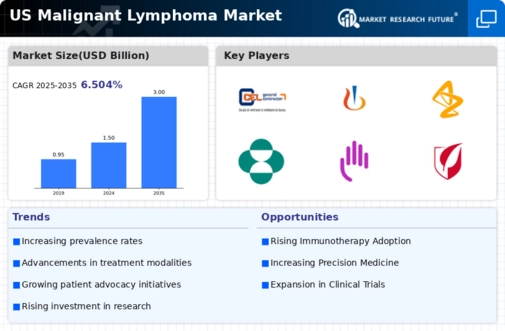Advancements in Treatment Modalities
The malignant lymphoma market is significantly influenced by advancements in treatment modalities. Recent developments in chemotherapy, radiation therapy, and novel agents have improved patient outcomes. The introduction of CAR T-cell therapy, for instance, has shown promising results in treating refractory cases, leading to a potential market growth of approximately 15% annually. Furthermore, the integration of personalized medicine approaches is enhancing treatment efficacy, thereby attracting more patients to seek care. The malignant lymphoma market is likely to see a surge in demand for these advanced therapies, as healthcare providers increasingly adopt innovative treatment strategies.
Investment in Research and Development
The malignant lymphoma market is bolstered by substantial investments in research and development (R&D) from both public and private sectors. Funding for lymphoma research has increased, with the National Institutes of Health allocating significant resources to study the disease. This financial support is crucial for the development of novel therapies and clinical trials, which are essential for advancing treatment options. The malignant lymphoma market is likely to see a proliferation of new drugs and therapies emerging from these R&D efforts, potentially transforming patient care and improving outcomes.
Rising Incidence of Malignant Lymphoma
The malignant lymphoma market is experiencing growth due to the increasing incidence of lymphoma cases in the US. According to the American Cancer Society, an estimated 81,560 new cases of non-Hodgkin lymphoma are expected in 2025, which indicates a rising trend. This increase in cases necessitates enhanced treatment options and drives demand for innovative therapies. As the population ages, the risk of developing lymphoma also escalates, further contributing to market expansion. The malignant lymphoma market is thus positioned to benefit from this growing patient population, leading to increased investments in research and development of new treatment modalities.
Growing Awareness and Screening Initiatives
Increased awareness about malignant lymphoma and proactive screening initiatives are driving the market forward. Educational campaigns by health organizations have led to a better understanding of lymphoma symptoms and risk factors, encouraging early diagnosis. This heightened awareness is reflected in the rising number of screenings and consultations, which are crucial for timely intervention. The malignant lymphoma market is benefiting from these initiatives, as early detection often results in improved treatment outcomes and higher survival rates. Consequently, this trend is likely to sustain market growth as more individuals seek medical advice and treatment.
Regulatory Support for Innovative Therapies
Regulatory bodies in the US are increasingly supportive of innovative therapies for malignant lymphoma, which is positively impacting the market. The expedited approval processes for breakthrough therapies and orphan drugs are facilitating quicker access to new treatments. This regulatory environment encourages pharmaceutical companies to invest in the development of novel agents, thereby enhancing the malignant lymphoma market. As a result, patients are likely to benefit from a wider array of treatment options, which could lead to improved survival rates and quality of life.

















Leave a Comment